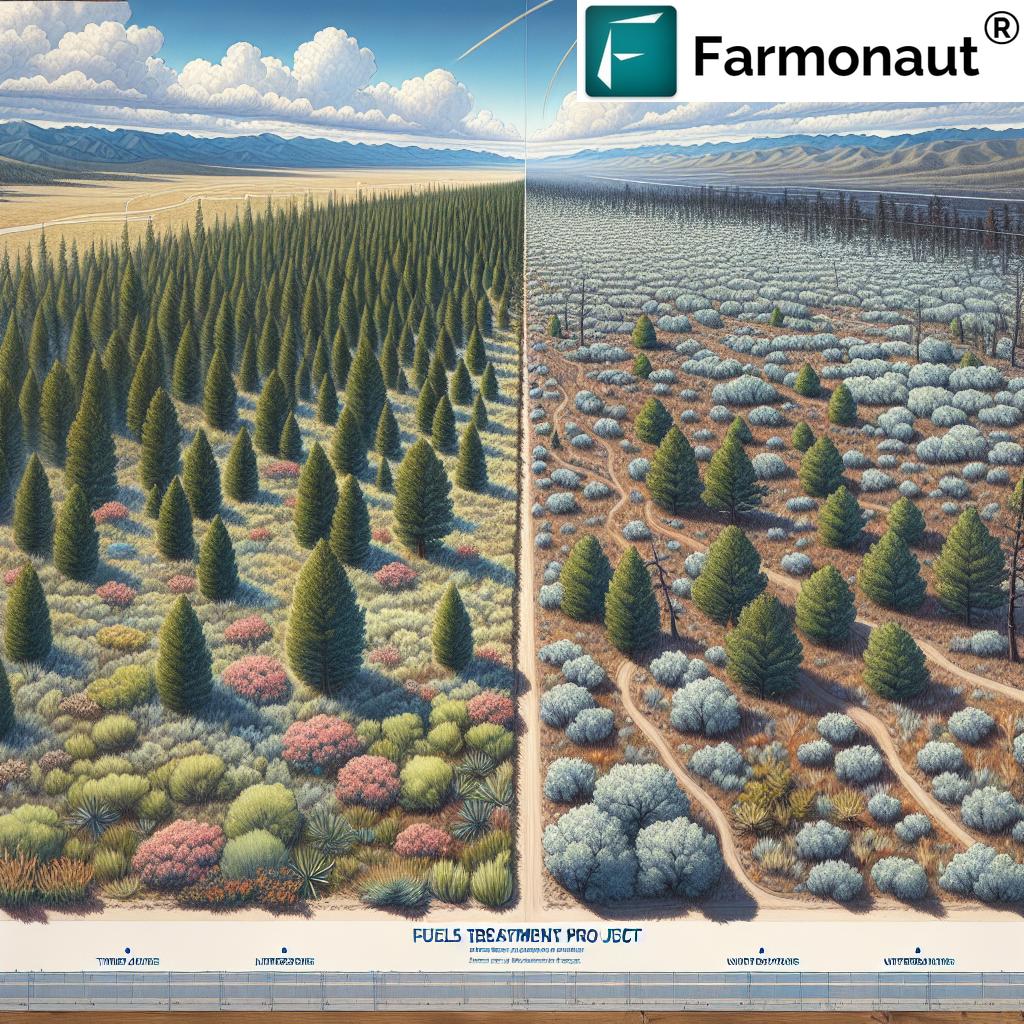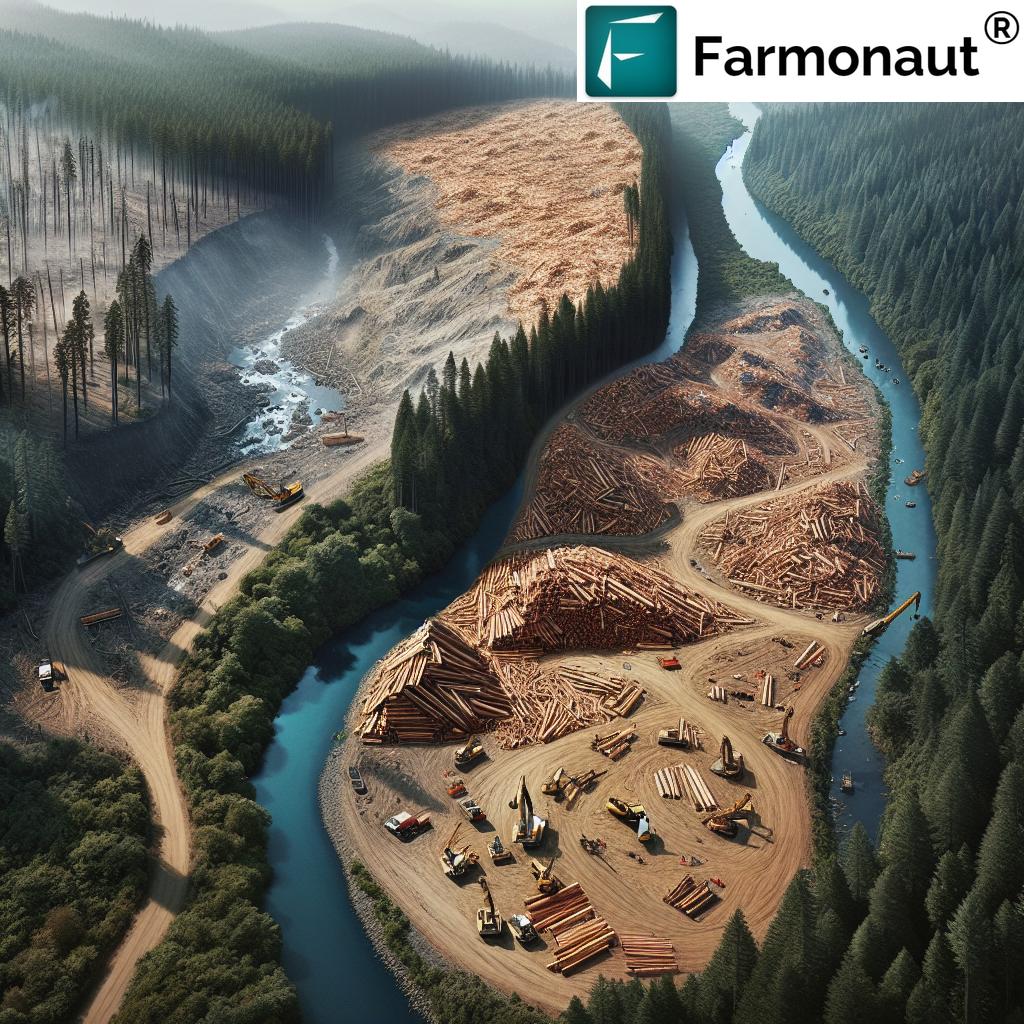Restoring Utah’s Landscape: Juniper Management Boosts Wildfire Resilience and Mule Deer Habitat in Herriman
“A 659-acre fuels treatment project in Utah’s Oquirrh Mountains aims to reduce wildfire risks and improve mule deer habitat.”
We are excited to share with you a groundbreaking initiative that is reshaping Utah’s landscape and setting a precedent for future habitat restoration efforts. In this comprehensive blog post, we’ll delve into the details of a recent juniper management project near Herriman, Utah, that is boosting wildfire resilience and enhancing mule deer habitat. This innovative approach to public lands management demonstrates effective techniques for balancing environmental conservation with community safety.
Understanding the Need for Juniper Management in Utah
Utah’s landscape has undergone significant changes over the past decades, largely due to fire suppression practices and urban development. These factors have allowed juniper trees to dominate vast areas, outcompeting native vegetation and creating a host of environmental challenges. Let’s explore why juniper management has become a crucial aspect of Utah’s land management projects.
- Increased wildfire risk
- Reduced habitat quality for wildlife
- Soil erosion and water retention issues
- Invasion of non-native species like cheatgrass
To address these concerns, the Bureau of Land Management (BLM) has implemented a 659-acre fuels treatment project on public lands near Hi-Country Estates, just outside Herriman. This project is a prime example of how juniper habitat management and wildfire risk reduction can go hand in hand to create a more resilient landscape.

The Herriman Project: A Closer Look
Located on the lower slopes of the Oquirrh Mountains, this area is crucial mule deer winter habitat. The project’s primary objectives include:
- Thinning dense juniper stands
- Creating hand piles for controlled burning
- Restoring native vegetation
- Enhancing landscape resilience
By focusing on these key aspects, the BLM aims to combat the challenges posed by urban development and mining while controlling cheatgrass invasion and preventing soil erosion. This comprehensive approach not only reduces wildfire threats but also enhances overall ecosystem health.
The Impact of Fire Suppression on Utah’s Landscape
“Decades of fire suppression have allowed junipers to dominate Utah’s landscape, reducing habitat quality and increasing fire dangers.”
Fire suppression, while initially implemented with good intentions, has had unintended consequences on Utah’s ecosystems. Over time, this practice has allowed juniper trees to proliferate unchecked, leading to:
- Dense juniper canopies that deplete understory vegetation
- Reduced biodiversity and habitat quality
- Increased risk of high-severity fires
- Altered water cycles and soil composition
Understanding these impacts is crucial for developing effective land management strategies. The Herriman project serves as a model for addressing these issues through targeted juniper management and native vegetation restoration.
Urban Wildfire Prevention: A Community Priority
As urban areas like Herriman continue to expand, the wildland-urban interface becomes increasingly vulnerable to wildfires. The juniper management project near Hi-Country Estates addresses this concern head-on by:
- Creating defensible space around residential areas
- Reducing fuel loads in high-risk zones
- Improving access for firefighters in case of emergencies
- Educating local communities about fire prevention
By integrating urban wildfire prevention into the broader landscape management plan, the BLM is taking a proactive approach to community safety while also addressing ecological concerns.
Enhancing Mule Deer Winter Habitat
One of the primary benefits of the Herriman juniper management project is the improvement of mule deer winter habitat. Mule deer populations in Utah have faced numerous challenges in recent years, including habitat loss and degradation. By thinning dense juniper stands and promoting the growth of native vegetation, the project aims to:
- Increase the availability of nutritious forage for mule deer
- Improve thermal cover during harsh winter conditions
- Create a mosaic of habitat types to support diverse wildlife needs
- Enhance connectivity between different habitat patches
These improvements are critical for maintaining healthy mule deer populations and supporting the overall biodiversity of the region.

Techniques for Juniper Management and Native Vegetation Restoration
The success of the Herriman project relies on a combination of proven techniques for juniper management and native vegetation restoration. Some of the key methods employed include:
- Mechanical thinning of juniper stands
- Selective hand-cutting of trees
- Creation of slash piles for controlled burning
- Seeding of native grasses, forbs, and shrubs
- Monitoring and adaptive management practices
These techniques are carefully implemented to minimize soil disturbance and protect existing native vegetation while effectively reducing juniper density.
Cheatgrass Invasion Control: A Critical Component
One of the significant challenges in restoring Utah’s landscapes is controlling the invasion of cheatgrass, an aggressive non-native annual grass. Cheatgrass thrives in disturbed areas and can quickly dominate a landscape, increasing fire frequency and intensity. The Herriman project incorporates several strategies to combat cheatgrass invasion:
- Timing management activities to minimize soil disturbance
- Prompt revegetation with competitive native species
- Targeted herbicide applications where necessary
- Ongoing monitoring and rapid response to new infestations
By addressing cheatgrass invasion as part of the overall management plan, the project aims to create a more resilient and diverse ecosystem.
Soil Erosion Prevention Methods in Juniper Management
Soil erosion is a significant concern in areas where juniper removal occurs. To mitigate this risk, the Herriman project employs several soil erosion prevention methods:
- Contour felling of juniper trees to create natural erosion barriers
- Retention of some juniper trees and slash to protect soil
- Seeding of native grasses with strong root systems
- Installation of erosion control structures in high-risk areas
- Phased treatment approach to maintain soil stability
These methods help ensure that the benefits of juniper management are not offset by increased soil erosion and degradation.
Collaborative Efforts in Public Lands Management
The success of the Herriman juniper management project is largely due to collaborative efforts between various stakeholders. Key partners in this initiative include:
- Bureau of Land Management (BLM)
- Utah Division of Wildlife Resources
- Local conservation groups
- Herriman City officials
- Resident volunteers
By bringing together diverse expertise and resources, the project demonstrates the power of collaborative public lands management in achieving both environmental and community goals.
Monitoring and Adaptive Management: Ensuring Long-term Success
To ensure the long-term success of the Herriman juniper management project, a robust monitoring and adaptive management plan has been put in place. This includes:
- Regular vegetation surveys to track changes in plant communities
- Wildlife population monitoring, particularly for mule deer
- Assessment of fire behavior and fuel loads
- Soil stability and erosion monitoring
- Adaptive management strategies based on monitoring results
This data-driven approach allows land managers to make informed decisions and adjust management practices as needed to achieve the best possible outcomes.
The Role of Technology in Landscape Management
Modern technology plays a crucial role in landscape management projects like the one in Herriman. Advanced tools and techniques help improve efficiency, accuracy, and decision-making. For instance, satellite-based monitoring systems can provide valuable insights into vegetation health and land use changes over time.
At Farmonaut, we understand the importance of leveraging technology in land management. Our crop plantation and forest advisory services utilize satellite imagery and AI to monitor vegetation health and provide actionable insights. While our focus is primarily on agricultural applications, the principles of remote sensing and data analysis are equally valuable in forest and rangeland management.
Community Engagement and Education
An essential aspect of the Herriman project is community engagement and education. By involving local residents and providing educational opportunities, the project aims to:
- Increase public understanding of landscape management goals
- Foster a sense of stewardship for public lands
- Encourage participation in conservation efforts
- Promote fire-wise practices in the wildland-urban interface
These efforts help ensure that the benefits of the project extend beyond the immediate treatment area and contribute to long-term community resilience.
Economic Benefits of Juniper Management
While the primary focus of the Herriman project is ecological restoration and wildfire prevention, it also brings several economic benefits to the region:
- Job creation in forestry and land management sectors
- Reduced costs associated with fighting catastrophic wildfires
- Improved grazing opportunities for livestock
- Enhanced recreational value of public lands
- Potential for sustainable utilization of removed juniper biomass
These economic advantages highlight the multifaceted benefits of well-planned landscape management projects.
Challenges and Lessons Learned
While the Herriman juniper management project has been largely successful, it has not been without challenges. Some of the key obstacles faced and lessons learned include:
- Balancing the needs of multiple stakeholders
- Adapting to changing weather conditions during project implementation
- Managing public perceptions and concerns about tree removal
- Ensuring long-term funding for monitoring and maintenance
By addressing these challenges head-on and learning from them, land managers can improve future projects and create more resilient landscapes.
Future Directions for Landscape Restoration in Utah
The success of the Herriman project paves the way for future landscape restoration efforts in Utah. Some potential directions for future work include:
- Expanding juniper management to larger areas across the state
- Integrating climate change adaptation strategies into restoration plans
- Exploring innovative funding mechanisms for long-term management
- Enhancing collaboration between public and private landowners
- Incorporating emerging technologies for more efficient and effective restoration
As we look to the future, it’s clear that landscape-scale restoration projects like the one in Herriman will play a crucial role in maintaining healthy ecosystems and resilient communities in Utah.
Comparative Analysis: Before and After Treatment
To better understand the impact of the Herriman juniper management project, let’s take a look at a comparative analysis of key aspects before and after treatment:
| Aspect | Before Treatment | After Treatment |
|---|---|---|
| Juniper Density | 80% coverage | 30% coverage |
| Native Vegetation Coverage | 15% coverage | 60% coverage |
| Wildfire Risk | High | Moderate |
| Mule Deer Habitat Quality | Poor | Good |
| Cheatgrass Presence | Moderate | Low |
| Soil Erosion Risk | High | Low |
This table clearly illustrates the significant improvements achieved through the juniper management project, highlighting its positive impact on various environmental factors.
Leveraging Technology for Landscape Monitoring
As we’ve seen throughout this blog post, effective landscape management relies heavily on accurate monitoring and data analysis. While our focus at Farmonaut is primarily on agricultural applications, many of the technologies we use can be adapted for landscape-scale monitoring in projects like the Herriman juniper management initiative.
For instance, our large-scale farm management tools could be adapted to monitor vast areas of treated land, tracking vegetation recovery and identifying potential issues early on. Similarly, our carbon footprinting capabilities could be used to quantify the carbon sequestration benefits of landscape restoration projects.
Frequently Asked Questions
Q: Why is juniper management necessary in Utah?
A: Juniper management is necessary in Utah due to decades of fire suppression that have allowed junipers to dominate the landscape, reducing habitat quality for wildlife, increasing wildfire risks, and causing soil erosion issues.
Q: How does juniper management benefit mule deer?
A: Juniper management benefits mule deer by improving their winter habitat, increasing the availability of nutritious forage, and creating a mosaic of habitat types that support diverse wildlife needs.
Q: What techniques are used in juniper management projects?
A: Techniques used in juniper management projects include mechanical thinning, selective hand-cutting, creation of slash piles for controlled burning, and seeding of native grasses, forbs, and shrubs.
Q: How does juniper management help prevent wildfires?
A: Juniper management helps prevent wildfires by reducing fuel loads, creating defensible spaces around urban areas, and promoting the growth of less fire-prone native vegetation.
Q: What are the long-term goals of landscape restoration projects like the one in Herriman?
A: The long-term goals include enhancing ecosystem health, improving wildlife habitat, reducing wildfire risks, controlling invasive species, and creating more resilient landscapes that can adapt to changing environmental conditions.
Conclusion: A Model for Future Landscape Restoration
The Herriman juniper management project serves as an excellent model for future landscape restoration efforts in Utah and beyond. By addressing multiple environmental challenges simultaneously – from wildfire prevention to habitat improvement – this project demonstrates the power of comprehensive, science-based land management approaches.
As we continue to face environmental challenges such as climate change, urbanization, and habitat loss, projects like this will become increasingly important. They not only help restore and maintain healthy ecosystems but also contribute to the safety and well-being of local communities.
While our work at Farmonaut focuses on agricultural applications, we recognize the interconnectedness of all landscapes. The principles of data-driven decision-making, technological innovation, and adaptive management that we apply in agriculture are equally valuable in forest and rangeland restoration projects.
We encourage land managers, conservationists, and policymakers to look to the Herriman project as an inspiration for future initiatives. By combining traditional ecological knowledge with cutting-edge technology and collaborative approaches, we can create more resilient, diverse, and healthy landscapes for generations to come.
For those interested in learning more about how technology can support landscape management and agricultural practices, we invite you to explore Farmonaut’s range of services:
For developers interested in integrating satellite and weather data into their own applications, check out our API and API Developer Docs.
Earn With Farmonaut: Affiliate Program
Earn 20% recurring commission with Farmonaut’s affiliate program by sharing your promo code and helping farmers save 10%. Onboard 10 Elite farmers monthly to earn a minimum of $148,000 annually—start now and grow your income!
















